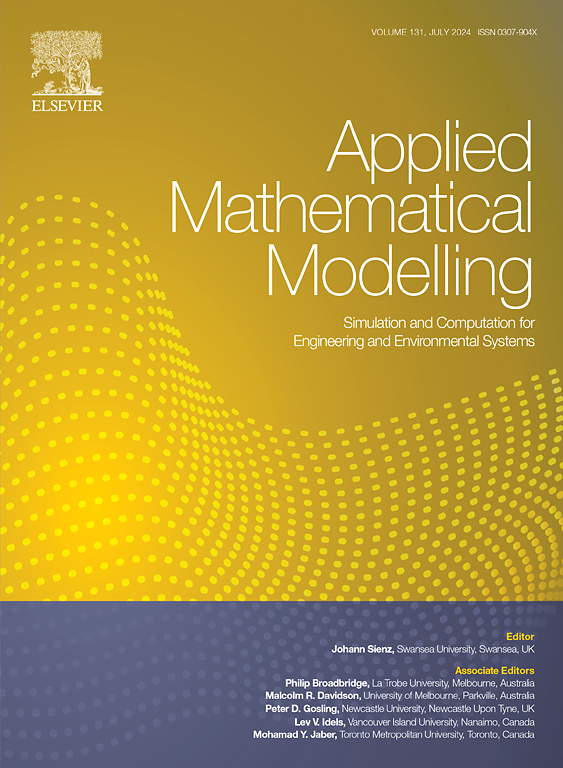A hydrodynamic model for simulating particles with generalised cross-sectional shapes in two-phase flow systems
IF 4.4
2区 工程技术
Q1 ENGINEERING, MULTIDISCIPLINARY
引用次数: 0
Abstract
Modeling the motion and interactions of particles with complex shapes in two-phase flow systems presents significant challenges. In this study, we aim to develop an efficient and stable hydrodynamic model for simulating two-phase flow systems involving particles with generalised cross-sectional shapes. Firstly, a geometric representation model (GRM) is developed to precisely characterize arbitrary particle geometries while maintaining uniform Lagrangian points spacing. Next, to overcome traditional limitations, a boundary thickening-based direct forcing Immersed Boundary Method (BTDF-based IBM) and a Characteristic-Based Split (CBS) method have been integrated within the finite element framework for the first time. Unlike iterative IBM, BTDF-based IBM enforces no-slip/no-penetration conditions without iteration, significantly improving efficiency and accuracy. The CBS method can ensure the stability of the flow field using equal-order velocity-pressure interpolation, providing reliable results for accurate particle force and motion calculations. The validity and robustness of our proposed method are demonstrated by the benchmark problems. The method has been applied to simulate two-phase flow systems involving particles with generalised cross-sectional shapes. The results offer new insights into the influence of particle shape and initial orientation on particle-fluid interactions, highlighting the applicability of the method as a powerful tool for simulating particle-fluid interactions in engineering applications.
模拟两相流系统中具有通用截面形状的颗粒的流体力学模型
对两相流系统中具有复杂形状的颗粒的运动和相互作用进行建模提出了重大挑战。在这项研究中,我们的目标是建立一个有效和稳定的流体动力学模型,用于模拟具有广义截面形状的颗粒的两相流系统。首先,在保持均匀拉格朗日点间距的情况下,建立了一种精确描述任意粒子几何形状的几何表示模型(GRM)。其次,为了克服传统的局限性,首次在有限元框架内集成了基于边界加厚的直接强迫浸入边界法(BTDF-based IBM)和基于特征的分裂(CBS)方法。与迭代式IBM不同,基于btdf的IBM无需迭代即可强制执行无滑移/无穿透条件,从而显著提高了效率和准确性。CBS方法通过等阶速度-压力插值保证了流场的稳定性,为精确的粒子力和运动计算提供了可靠的结果。通过基准问题验证了该方法的有效性和鲁棒性。该方法已应用于模拟具有广义截面形状的颗粒的两相流系统。结果为颗粒形状和初始方向对颗粒-流体相互作用的影响提供了新的见解,突出了该方法作为模拟工程应用中颗粒-流体相互作用的强大工具的适用性。
本文章由计算机程序翻译,如有差异,请以英文原文为准。
求助全文
约1分钟内获得全文
求助全文
来源期刊

Applied Mathematical Modelling
数学-工程:综合
CiteScore
9.80
自引率
8.00%
发文量
508
审稿时长
43 days
期刊介绍:
Applied Mathematical Modelling focuses on research related to the mathematical modelling of engineering and environmental processes, manufacturing, and industrial systems. A significant emerging area of research activity involves multiphysics processes, and contributions in this area are particularly encouraged.
This influential publication covers a wide spectrum of subjects including heat transfer, fluid mechanics, CFD, and transport phenomena; solid mechanics and mechanics of metals; electromagnets and MHD; reliability modelling and system optimization; finite volume, finite element, and boundary element procedures; modelling of inventory, industrial, manufacturing and logistics systems for viable decision making; civil engineering systems and structures; mineral and energy resources; relevant software engineering issues associated with CAD and CAE; and materials and metallurgical engineering.
Applied Mathematical Modelling is primarily interested in papers developing increased insights into real-world problems through novel mathematical modelling, novel applications or a combination of these. Papers employing existing numerical techniques must demonstrate sufficient novelty in the solution of practical problems. Papers on fuzzy logic in decision-making or purely financial mathematics are normally not considered. Research on fractional differential equations, bifurcation, and numerical methods needs to include practical examples. Population dynamics must solve realistic scenarios. Papers in the area of logistics and business modelling should demonstrate meaningful managerial insight. Submissions with no real-world application will not be considered.
 求助内容:
求助内容: 应助结果提醒方式:
应助结果提醒方式:


